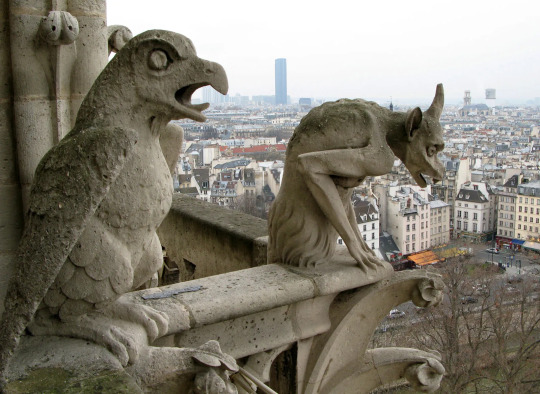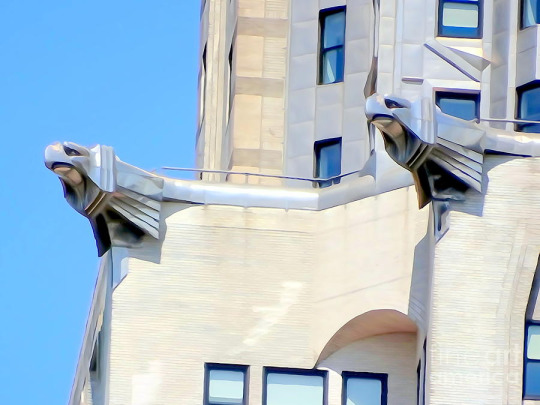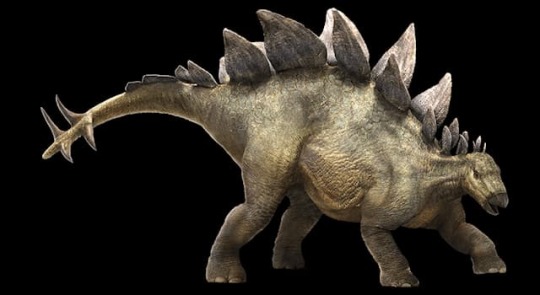#stegosaurine
Text
Dinofact #47
The distinctive array of four spikes on the end of stegosaurines' tails is called a thagomizer.
Source: wikipedia
#dinosaur#dinosaurs#paleontology#thagomizer#stegosaurus#stegosaurid#stegosaurids#stegosaurine#stegosaurines#stegosauridae#fun facts#trivia#dinosaur trivia#dinosaur fun facts#10th#october#2022#october 10th#october 2022#october 10th 2022
77 notes
·
View notes
Text
The Common Gargoyle
Kingdom: Animalia
Phylum: Chordata
Class: Mammalia
Order: Artiodactyla
Family: Bovidae
Subfamily: Caprinae
Tribe: Grotini
Genus: Gargula
Species: G. pteracheirus

Gargula pteracheirus (wing-handed cave-dweller) also known as the common gargoyle, is a species of sapient, winged, even-toed ungulates found on every continent except Antarctica. They were originally classified under the genus Pseudochimera because their physical appearance suggested they were an amalgam of several distinct species, but genetic testing has confirmed that all of their features are examples of convergent evolution in the 20 million years since they split from other bovids. Their back armor and tails most closely resemble the scuta of crocodilians, with defensive clubs resembling those found on stegosaurine dinosaurs, and their front hooves have evolved into winged hands more similar in appearance to those of pterosaurs than extant flying mammals.
Note: only the adults of the species can achieve powered "flight," here in quotation marks because they can't get very far off the ground nor fly for long distances, though they do make excellent gliders. Juveniles (and under-developed adults) do not have fully developed keels, so the muscles anchoring their wings to their torsos do not have enough leverage for flight of any kind.
Unlike other ruminants, gargoyles are opportunistic omnivores, like their distant cousins the pigs, having lost the need to chew cud and ferment their food in multiple stomachs. They evolved intelligence long before primates, though they never spread beyond their ancestral homelands in the Caucasus Mountains and Central Asia until early hominins spread out of Africa. Since first contact, the two lineages have developed a close symbiotic relationship, gargoyles acting as shepherds over a burgeoning humanity, teaching them, nurturing them, helping them thrive. In modern society, gargoyles are honor bound to protect the lands they inhabit. Adults who have proven themselves fit for duty may be granted a duchy/principality/estate called a grotto to live on and dedicate their lives in service to. It is important to note that gargoyles are not sovereigns. They do not rule over their grottos, they simply defend them like watchdogs.
Famous grottos include Notre-Dame de Paris in France and the Chrysler Building in the United States.



The individual known as Grottweiler, nicknamed Grott, is the equivalent of a young adult human (late teens, early twenties), though his diminutive size suggests that he is a late bloomer. Maybe he'll have a growth spurt someday, maybe not, it's too soon to tell. Without his horns, he is roughly the size and shape of Danny DeVito, but with them he is exactly as tall as a dude-bro who thinks it's impressive to put his height in his tinder bio.

Grott is a guardian-in-training, so the elders have assigned him a practice grotto, a vacant lot behind a 24-7 gas station mini mart in the outskirts of Miami, Florida. It is his sworn duty to protect that vacant lot from the forces of evil, which is a considerable undertaking for a trainee who lives in an evil city in an eviler state. His wards are mostly wild animals (armadillos, raccoons, possums, crabs, iguanas, the occasional human teenager who got kicked out of the gas station for loitering), but he would die for each and every one of them. He wants nothing more than for his community to thrive, and though his legal responsibilities extend only over the half-acre of his grotto, he has taken it upon himself to serve the needs of the entire neighborhood, perhaps one day even the entire Miami metropolitan area; the journey of 1000 miles starts with a single step. He often butts heads with cops and politicians because they think he's a menace. They don't need a meddlesome goat trying to "help people" and "improve lives" and "do good for the community." The local leaders would never stand for such subversive behavior!
#grott#grottweiler#gargoyle#oc#fursona#furry art#furry oc#sfw furry#fursona friday#chimera#my drawings#my art#digital art#lore#oc lore#oc stuff
11 notes
·
View notes
Note
Where can i read your fics!!!
hey anon!! i haven't begun posting anything yet (i know...gotta kick my ass into gear) but my AO3 is here: https://archiveofourown.org/users/stegosaurine ...watch this space 👀
13 notes
·
View notes
Text

Today's Fun Fact PLUS Word Of TheDay (except I don't do either one every day. Actually, this is the first time): the group of spikes on a stegosaurus's tail is called a thagomizer (it sounds like a joke bc at first it WAS a joke, but then legit science ppl began to use it!).
Bonus cool related facts:
✰ the way you'd say something was "like a stegosaurus" would be with the adjective "stegosaurine"
✰ stegosaurus could grow to 30 feet long and 14 feet tall
✰ a similar dinosaur called an Ankylosaur had a "tail club" (see NOTE, bottom)
✰ the T-Rex lived closer in time to us humans than to the Stegosaurus
Anyway, today's dinosaur trivia has nothing at all to do with these lights, which I just thought were pretty badass:
The regular version (here) https://www.polepalsolarlightingsystem.com/catalog/p-100113/solar-flagpole-top-light-7th-generation#.ZG0luqXMKM8
and then the even-more-badass version with a double row of lights (here):
https://www.polepalsolarlightingsystem.com/catalog/p-100077/double-row-solar-flagpole-top-light-32led#.ZG0TZKXMKM8
…because it's warm and spring-y today, but also kind of gloomy, and an automatic light just perks up your flag and your whole yard, plus you don't have to worry about it (because it's automatic… lol).
NOTE: at first I thought that meant a group of dinosaurs with cool tails, but it's actually just a lump of bone at the tip of the tail
0 notes
Text
What is the informal term for the spikes on the end of a dinosaur's tail?

A thagomizer is the informal term for the cluster of four spikes on the tail of stegosaurine dinosaurs, for instance, the Stegosaurus. The name was coined in 1982 by cartoonist Gary Larson (born 1950) for his comic 'The Far Side', in which he claims the spikes were named after a fictional caveman called Thag Simmons.
The term "thagomizer" was adopted by Kenneth Carpenter (born 1949), a paleontologist at the Denver Museum of Nature and Science. It has since become an informal anatomical term for the four tail spikes.
These spikes were probably used as a defensive measure against predators. They were not, however, ever used to attack humans as Larson's comic implies. Stegosaurine dinosaurs and humans did not exist in the same era. Larson jokingly wrote, "there should be cartoon confessionals where we could go and say things like, 'Father, I have sinned – I have drawn dinosaurs and hominids together in the same cartoon.'"
2 notes
·
View notes